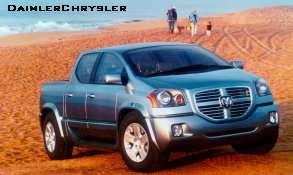 |

|
  |
|
|
|
|
|
|
|
Story by Chrysler: 9th January 2000 ADVENTURES IN SPACE: DODGE MAXXcab The World's First ‘Passenger Priority’ Truck Traditionally, pickup trucks have been designed with cargo and hauling in mind. It was all about utility in the 1930s and '40s. While in recent years more attention has been given to the passengers with larger cabs, it’s bed dimensions and payload which are still key factors in any true pickup truck. |

|
|
Enter the Dodge MAXXcab concept truck, the world's first Passenger Priority truck, which was unveiled at the 2000 North American International Auto Show in Detroit today. DaimlerChrysler's Dodge MAXXcab is a true pickup truck - but one with cab-forward design and saloon-like ride, handling, space, comfort and luxury. "Just as cab-forward changed the architecture of our passenger cars, Passenger Priority design might influence an entire vehicle line," said Tom Gale, Executive Vice President Product Development and Design. "The Dodge MAXXcab is tangible proof of our ability to reach with design. Not only do we achieve truly new exterior proportions, but with MAXXcab we literally reinvent the truck interior image." The Dodge MAXXcab concept vehicle doubles as an office-on-wheels or as a mobile daycare centre, while still offering a half-ton payload and enough loadbed space for weekend projects and hobby equipment. The bed measures 52.7" long by 56.7" wide by 24" deep - wider and deeper than today's full-size truck boxes - and comes with an integrated picnic table and chairs for the occasional spur-of-the-moment tailgate party. "My inspiration came from my own experience," said Clyde Ney, Design Manager responsible for the MAXXcab interior. "I've had pickup trucks for more than 10 years and worked on the exterior design of the current Dodge Ram. So I knew what I liked in a pickup truck. When this project came up, I also asked my wife and six year old son what they would change. MAXXcab offers a luxurious front cabin with cream pillow-top leather-tailored seats, a sports saloon-style instrument panel with brushed aluminium details and Navy door inserts, adjustable pedals and a child-focused rear cabin." The driver ‘Infotronic’ system accommodates all data and information needs while away from the office. The centre console houses a toaster-style pop-up ‘plug-and-play’ laptop computer with liquid crystal displays in the instrument panel and in the rear of the console itself. A voice recognition system allows the driver to access the mobile office screens and the Internet for real-time weather updates, and traffic information and e-mail. Voice commands also control the vehicle's navigation and diagnostics systems and telephone. In the rear, three minivan-style, built-in child safety seats accommodate kids of all ages while an ‘Edu-tainment’ system with DVD player, Internet access and a hand-held sketch pad will keep them busy. Added Ney: "Remember when your parents were on a quest to find that antique armoire or went out to buy a power generator or a week's-worth of groceries, and you were 'forced' to join them? In the Dodge MAXXcab, these trips will be fun." The middle rear seat is power-controlled from the front doors. This allows for the parents to move the seat close to the front seats and create a ‘kid-cocoon’. It also makes it easier for the front passenger to tend to an infant. A small overhead ‘kid-view’ camera monitors the rear cabin. Additional side bolsters on top of the child seats create a comfortable nap-rest while lower side nets will keep the toys close to the toddlers. All seats have integrated speakers in the head restraints using digital signal processing electronics that allow each occupant to customise their sound environment. For example, road noise can be minimised for every passenger and while adults are listening to the radio, children could be listening to video games or movies. In order to manage the increased electrical demands for ‘infotronic’ systems, engineers are working on a new 42-volt electrical system. The higher power and efficiency from a 42-volt system reduces vehicle weight and improves the performance of most electrical systems - from steering, to air conditioning and mobile office systems. The efficiency also carries over to fuel consumption, which can be improved by up to five percent. "The Dodge MAXXcab is the first pickup truck to give the highest priority to the passengers," said Michael Castiglione, Design Manager at DaimlerChrysler's Pacifica Advanced Product Design Center in Carlsbad, California. Castiglione, the exterior designer, proposed the Passenger Priority concept truck as part of a Design Leadership Project at Pacifica. "In doing so, we created unique design proportions. But it’s still a true Dodge Truck - bold and powerful. Every design element, no matter how small, supports that image." MAXXcab's exterior design, with its short front and rear overhangs and cab-forward stance, reflects the appearance of semi-trucks. Its high beltline, strong body feature line, tall bumpers and large wheel flares give this concept the bold presence of a cab-over truck. While extremely roomy inside, overall length is just 2.5 inches larger than the Dodge Grand Caravan minivan. The massive in-your-face Dodge-signature cross-hair grille, flanked by oversized headlamps signals the vehicle's capability. A 4.7-litre Next Generation Magnum V-8 engine coupled to a multi-speed electronic automatic transmission allows for a sprint to 60 mph in 7.7 seconds, a quarter-mile run in 16.1 seconds and a top speed of 115 mph. The Dodge MAXXcab is finished in Butane Blue Pearl paint. Eighteen-inch wheels and tyres and independent short-and-long-arm front and rear suspension with custom torsion bars give MAXXcab smooth, saloon-like ride and handling. Custom cross members allow for maximum passenger and cargo volume. Added Gale: "The MAXXcab concept truck is still a Dodge Truck with all its capability. Passenger Priority does not mean cargo requirements were forgotten." |
|